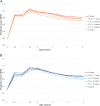The new child food package is associated with reduced obesity risk among formula fed infants participating in the Special Supplemental Nutrition Program for Women, Infants and Children (WIC) in Los Angeles County, California, 2003-2016
- PMID: 32041634
- PMCID: PMC7011546
- DOI: 10.1186/s12966-020-0921-3
The new child food package is associated with reduced obesity risk among formula fed infants participating in the Special Supplemental Nutrition Program for Women, Infants and Children (WIC) in Los Angeles County, California, 2003-2016
Abstract
Background: The Special Supplemental Nutrition Program for Women, Infants and Children (WIC) changed the food packages provided to its participants in 2009, to better align them with the Dietary Guidelines for Americans. Previous research found that the 2009 WIC food package change was associated with reduced obesity risk, particularly among breastfed infants but also among those who were never breastfed. The objective of this study was to determine if the new child food package introduced in 2009, including more produce and whole grains for 1-4-year old children, was associated with healthier growth trajectories and reduced obesity risk at age 4 years among children who were exclusively formula fed during infancy.
Methods: Administrative data on WIC-participating children in Los Angeles County, 2003-2016, were used (N = 74,871), including repeated measures of weight and length (or height); child's age, gender, and race/ethnicity; maternal education and language; and family poverty. Gender-stratified spline mixed models were used to examine weight-for-height z-score (WHZ) growth trajectories from 0 to 4 years and Poisson regression models were used to assess obesity (BMI-for-age > 95th percentile) at age 4. The main independent variable was duration of receipt (dose) of the new child package, categorized as 0, > 0 to < 1, 1 to < 2, 2 to < 3, 3 to < 4, and 4 years.
Results: WHZ growth trajectories were similar for children across new child package dose groups. Boys and girls who were fully formula fed during infancy but received the new child food package for 4 years had a 7% (RR = 0.93; 95%CI = 0.89-0.98) and a 6% (RR = 0.94; 95%CI = 0.89-0.99) lower obesity risk, respectively, compared to children who received the new child food package for 0 years. There were no differences in obesity risk for children receiving < 4 years of the new child package vs. 0 years.
Conclusions: Providing healthy foods during childhood to children who were exclusively formula fed as infants was associated with modest improvements in obesity outcomes. While breastfeeding promotion should still be prioritized among WIC participants, providing healthy foods during childhood may provide health benefits to formula fed children, who comprise a sizeable proportion of children served by WIC.
Keywords: Formula feeding; Los Angeles County; Obesity; WIC.
Conflict of interest statement
The authors declare that they have no competing interests.
Figures


Similar articles
-
The Association between the 2009 WIC Food Package Change and Early Childhood Obesity Risk Varies by Type of Infant Package Received.J Acad Nutr Diet. 2020 Mar;120(3):371-385. doi: 10.1016/j.jand.2019.09.014. Epub 2019 Dec 9. J Acad Nutr Diet. 2020. PMID: 31831385
-
The 2009 Special Supplemental Nutrition Program for Women, Infants, and Children (WIC) food package change and children's growth trajectories and obesity in Los Angeles County.Am J Clin Nutr. 2019 May 1;109(5):1414-1421. doi: 10.1093/ajcn/nqy347. Am J Clin Nutr. 2019. PMID: 31011750
-
The role of income and neighbourhood poverty in the association between the 2009 Special Supplemental Nutrition Program for Women, Infants and Children (WIC) food package change and child obesity among WIC-participating children in Los Angeles County, 2003-2016.Public Health Nutr. 2021 Sep;24(13):4212-4219. doi: 10.1017/S1368980020005200. Epub 2020 Dec 22. Public Health Nutr. 2021. PMID: 33349277 Free PMC article.
-
USDA Special Supplemental Nutrition Program for Women, Infants and Children (WIC) Vendor Criteria: An Examination of US Administrative Agency Variations.Int J Environ Res Public Health. 2021 Mar 29;18(7):3545. doi: 10.3390/ijerph18073545. Int J Environ Res Public Health. 2021. PMID: 33805495 Free PMC article. Review.
-
Maternal and Child Outcomes Associated With the Special Supplemental Nutrition Program for Women, Infants, and Children (WIC) [Internet].Rockville (MD): Agency for Healthcare Research and Quality (US); 2022 Apr. Report No.: 22-EHC019. Rockville (MD): Agency for Healthcare Research and Quality (US); 2022 Apr. Report No.: 22-EHC019. PMID: 35503870 Free Books & Documents. Review.
Cited by
-
A Scoping Review to Identify Community- and Societal-Level Strategies Evaluated from 2013 to 2023 for Their Potential Impact on Child Well-Being in the United States.Children (Basel). 2024 Aug 31;11(9):1070. doi: 10.3390/children11091070. Children (Basel). 2024. PMID: 39334603 Free PMC article.
-
Addressing obesity in the first 1000 days in high risk infants: Systematic review.Matern Child Nutr. 2021 Jul;17(3):e13178. doi: 10.1111/mcn.13178. Epub 2021 Mar 29. Matern Child Nutr. 2021. PMID: 33780128 Free PMC article.
-
Advancing Health Equity Efforts to Reduce Obesity: Changing the Course.Annu Rev Nutr. 2022 Aug 22;42:453-480. doi: 10.1146/annurev-nutr-092021-050805. Epub 2022 Apr 13. Annu Rev Nutr. 2022. PMID: 35417194 Free PMC article. Review.
-
Regional and sociodemographic differences in average BMI among US children in the ECHO program.Obesity (Silver Spring). 2021 Dec;29(12):2089-2099. doi: 10.1002/oby.23235. Epub 2021 Aug 31. Obesity (Silver Spring). 2021. PMID: 34467678 Free PMC article.
References
-
- U.S. Department of Agriculture, Economic Research Service, 2019. WIC Program. Available at: https://www.ers.usda.gov/topics/food-nutrition-assistance/wic-program/ [accessed Jul 15 2019].
-
- Taylor J, 2006. Updating the WIC food packages: It's about time. National Health Policy Forum, issue brief no. 816. George Washington University Available at: https://www.nhpf.org/library/issue-briefs/IB816_WICFoodPackage_11-02-06.pdf [accessed on Feb 10 2017]. - PubMed
-
- Institute of Medicine of the National Academies, Food and Nutrition Board, 2005. WIC food packages: Time for a change. Available at: https://www.fns.usda.gov/wic/wic-food-packages-time-change [accessed on Sept 23 2019].
-
- Whaley SE, Koleilat M, Whaley M, Gomez J, Meehan K, Saluja K. Impact of policy changes on infant feeding decisions among low-income women participating in the special supplemental nutrition program for women, infants, and children. Am J Public Health. 2012;102(12):2269–2273. doi: 10.2105/AJPH.2012.300770. - DOI - PMC - PubMed
Publication types
MeSH terms
Grants and funding
LinkOut - more resources
Full Text Sources
Medical

